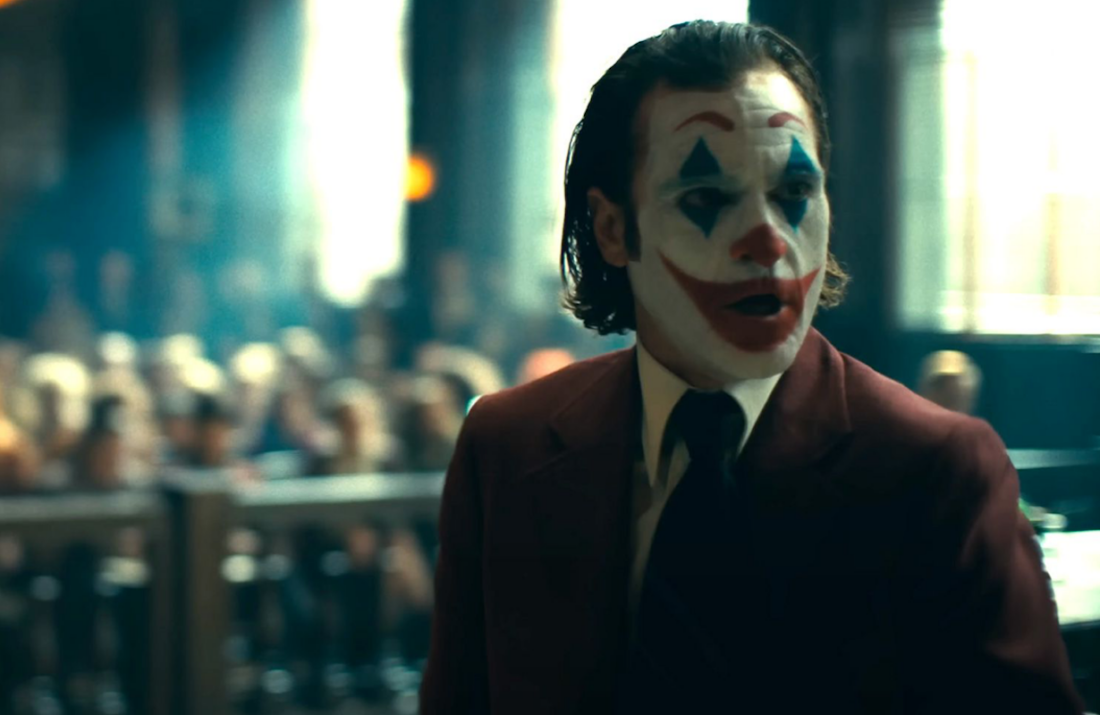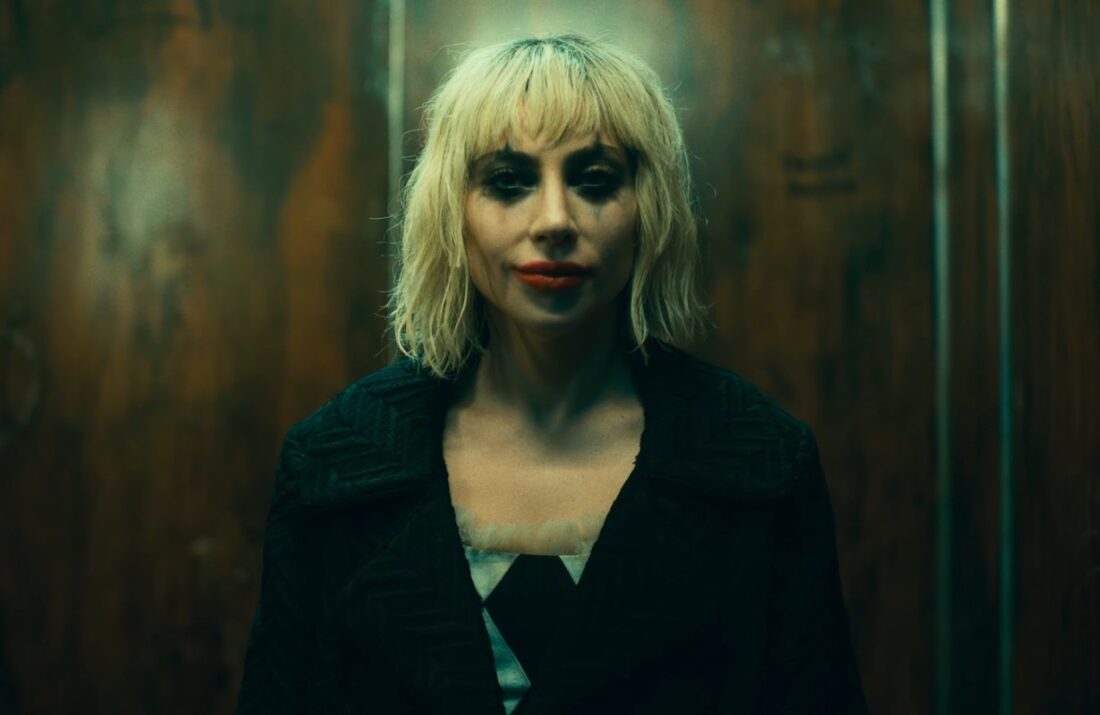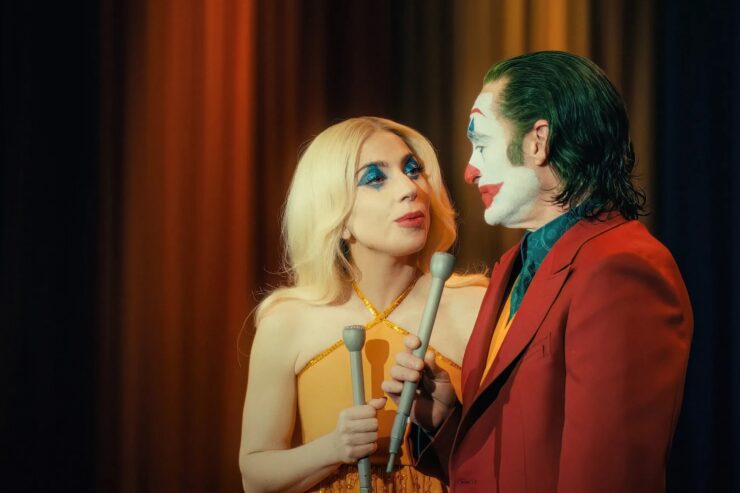From August 2017 – January 2020, Keith R.A. DeCandido took a weekly look at every live-action movie based on a superhero comic that had been made to date in the Superhero Movie Rewatch. He’s periodically revisited the feature to look back at new releases, as well as a few he missed the first time through.
While critical response was all over the map, the box office for 2019’s Joker was undeniably huge, plus it got lots of award consideration. A sequel was inevitable, and co-writer/director/co-producer Todd Phillips was given pretty much carte blanche to do whatever the heck he wanted for said sequel.
Phillips originally intended the 2019 film to be standalone, and a big reason why Joaquin Phoenix took the role was because—unlike most comic-book roles in the twenty-first century—it didn’t require a commitment beyond one film. But Phoenix was really taken with the role of Arthur Fleck, and even had a dream about Fleck on stage singing that was a major inspiration for the musical nature of the sequel. Indeed, for a time this sequel was going to be a Broadway show rather than a movie…
Production took a while, partly due to the 2020 pandemic (which killed the whole Broadway show idea) and changes in the hierarchy at Warner Bros. The sequel was officially green-lit in the summer of 2022. Phoenix thought it would be good to have a female Joker to play off of, so Phillips decided to include a version of Joker’s sometime moll Harley Quinn. Lady Gaga was cast in that role.
Unlike the first movie, which was filmed entirely in New York City and its environs, this was filmed in Los Angeles, with most of the scenes taking place either in Arkham State Hospital or a courtroom, though they did go back to the Big Apple to film a scene at the W. 167th Street staircase in the Bronx (which have been referred to since 2019 as “the Joker stairs” after their use in the prior movie).
Back from Joker (besides Phoenix) are Zazie Beetz as the woman Fleck imagined a love affair with, Sharon Washington as Fleck’s social worker, and Leigh Gill as the clown co-worker whose life Fleck spared, all three of whom testify at his trial.
New to this film are Gaga as Harleen “Lee” Quinzel; Catherine Keener as Fleck’s lawyer; Bill Smitrovich as the judge in Fleck’s trial; Harry Lawtey as Harvey Dent, the assistant DA prosecuting Fleck; Steve Coogan as Paddy Meyers, a TV personality who interviews Fleck just before his trial starts; Ken Leung as a psychiatrist who examines Fleck; Brendan Gleeson, John Lacy, Mac Brandt, George Carroll, and Tim Dillon as guards at Arkham; and Jacob Lofland, Connor Storrie, and Alfred Rubin Thompson as other Arkham inmates.
While the movie had a budget three times that of its predecessor, it tanked in theaters, and also was critically drubbed.

Joker: Folie à Deux
Written by Scott Silver & Todd Phillips
Directed by Todd Phillips
Produced by Todd Phillips, Emma Tillinger Koskoff, Joseph Garner
Original release date: October 4, 2024
“See, isn’t this more fun than a movie?”
The movie opens with an animated sequence called “Me and My Shadow,” in which Arthur Fleck puts on the Joker makeup and performs on stage, but is upstaged by his shadow, which puts on the Joker makeup and performs without him initially, though eventually Fleck triumphs over his errant shadow.
This turns out to be a dream. Fleck is in the criminal ward of Arkham State Hospital awaiting trial for five counts of murder. (The three dudebros on the subway, his fellow clown, and Murray Franklin. They don’t know that he killed his mother, too.) Fleck has a certain banter going with the guards where he tells a joke and they give him a cigarette.
He meets with his lawyer, Maryanne Stewart, who brings him to a psychiatrist, who Stewart hopes will give him a diagnosis of multiple personality disorder (these days called dissociative identity disorder, but MPD was what they called it in the 1980s), hoping to blame the murders on the Joker as a separate personality from Fleck. The shrink asks leading questions, which Fleck answers half-heartedly.
Fleck passes by the music therapy group, which includes a blonde woman who makes goo-goo eyes at Fleck. Later, Fleck is allowed to join that therapy group. He and the blonde, whose name is Lee Quinzel, start talking. Lee says she’s from the same neighborhood as Fleck, and admires what he did. She’s even seen the TV movie they made about him twenty times. She’s in Arkham because she set her house on fire. Her father died when she was a kid also.
The two of them keep talking, and also break into song. At one point, the inmates are watching The Band Wagon, and during “That’s Entertainment,” Lee sets fire to the sheet music on the piano and tosses it into the piano, starting a huge fire. Lee and Fleck both manage to escape to the street, but are eventually caught and brought back.
Fleck has more fantasies about him and Lee performing together, but he’s also put into solitary confinement. Lee is able to get in to see Fleck thanks to a friendly guard, and she says that she’s being kicked out of Arkham to get away from his influence. But their visit turns conjugal before she leaves.
Stewart has set up Fleck to be interviewed on television by Paddy Meyers. (Meyers allows as how this is risky, given how Fleck’s last TV interview went, but it’s in a jail cell with lots of protection around.) Fleck at one point breaks into song, which he does for Lee, who is watching at a TV store window. She’s so taken that she breaks the window and steals one of the portable TVs in the window.
The trial starts, and for the first time ever, it will be televised. This enables Fleck’s fellow Arkham inmates (as well as the rest of Gotham) to watch the proceedings. The courtroom itself is filled with Joker groupies. Fleck spends more time responding to the groupies than he does paying attention to the trial. Prosecutor Harvey Dent calls a Dr. Victor Liu, who testifies to Fleck not being crazy, but knowing full well what he did. Stewart then expertly pokes holes in Liu’s diagnosis, raising questions that Liu never asked and calling into question whether you can truly psychoanalyze someone in 89 minutes as he did.
After court is adjourned, Stewart tells a surprised Fleck that Lee is not from his neighborhood, both her parents are alive, and she checked herself into Arkham voluntarily (and then checked out just as voluntarily). When Lee visits him at Arkham, she admits to the lies, and that she only watched the TV movie five times, but she says she wanted to be closer to him. She also says that she’s moved into his old apartment—which doesn’t really thrill him all that much, as he has no good memories of that place—and is also pregnant after their solitary-cell tryst.
Lee has also convinced him to stop taking his meds and that his lawyer isn’t doing him any good. Fleck dismisses Stewart and moves to represent himself. Furthermore, he is able to represent himself while in his Joker suit and makeup, the judge (though reluctant to allow it) having found no legal reason to prevent him from doing so.
Dent’s next witness is Gary Puddles, the clown who worked with Fleck, and witnessed his murder of their coworker Randall Kleinmanhoffer. While talking in a fake Southern accent for no compellingly good reason, Fleck questions Puddles (and also makes fun of his last name, which he never knew before), who expresses the intensity of the trauma he experienced watching Fleck kill Keinmanhoffer. Dent also calls the social worker who spoke to Fleck at the end of the last movie (who, despite us seeing Fleck leave his session with her all covered in blood, apparently is alive and well, leading us to realize that the closing scene of the last movie was a fantasy of Fleck’s).
The prosecution rests and then, to everyone’s surprise, the defense rests as well, with Fleck—obviously moved by Puddles’ testimony—offering nothing in his own defense, though he does carry on about how badly he’s abused by the Arkham guards. This proves to be a pretty major tactical error on his part. When he’s brought back to Arkham, the guards kick the shit out of him and toss him half-naked into his cell. When one of the other prisoners tries to rise to Fleck’s defense, one of the guards strangles him to death.
A very subdued Fleck gives his closing arguments, in which he renounces the Joker persona completely and admits to his own guilt, including confessing to murdering his mother. Lee storms out of court in anger at this. The jury takes very little time to deliberate, finding him guilty of the first two counts of murder, but before they can get to the third, fourth, and fifth, a bomb goes off, blowing out one wall of the courtroom. Fleck escapes to the streets (passing by Dent, whose face is scarred by the explosion, ahem ahem), aided by someone in a Joker costume.
He finds Lee—wearing a variation of his face makeup—on the staircase near his old apartment. She rejects him, disappointed that he’s renounced the Joker. Fleck reminds her that she’s carrying his kid, but she doesn’t care, and walks away. He’s then apprehended by the police and brought back to Arkham.
On his way to see a visitor, Fleck is stopped by an inmate who tells him a joke, the punchline of which is stabbing Fleck in the belly. As Fleck collapses to the floor and bleeds out, his killer laughs hysterically and carves a Glasgow smile onto his own cheeks.

“I don’t want to sing anymore”
Joker was an interesting movie. Five years later, I’m still not sure if it’s successful or not, but it was at the very least a fascinating work of art that was worthy of complex discussion. It had its flaws, not the least of which was that its theoretical theme of showing the origin of a super-villain serial killer was undercut by all his victims being bad people who in some sense “deserved” it.
Folie à Deux is almost none of those things. It isn’t interesting, it isn’t successful, it isn’t fascinating. It does, however, have flaws, but in this case, that’s pretty much all we got.
Joker tried to paint Arthur Fleck as a victim of society’s ills, a picture that indeed Stewart tries to paint in her capacity as his lawyer in this film. But where you would expect the followup to that to be him going all the way into Joker-dom, as it were, Fleck instead just kind of stalls out. He has virtually no agency through much of the movie, and when he finally does have some (taking over his own defense), he’s a complete failure. He’s a pathetic figure who tells bad jokes for cigarettes and lets himself get manipulated by a groupie.
I spent most of this movie bored—the pacing of this film could generously be called languid—but the thing that got an emotional response out of me was the treatment of Harley Quinn. One of Phillips’ alleged goals with these two movies was to do a more grounded, realistic version of the clown prince of crime. But one of the few hyper-realistic things about the Joker of the comics (and the 1990s animated series, which is where Harley first appeared) is his relationship with Harley, which is a pretty classic case of a charismatic man gaslighting, abusing, and corrupting a woman. Instead, Phillips decides to flip that, making Lee the abuser, the manipulator, the liar. Fleck is an automaton throughout most of the movie, only coming alive when he meets Lee, but then when he rejects the Joker persona in court, Lee rejects him, leaving him broken and empty again.
And then there’s the fact that this movie is trying to be a musical. Alas, nobody told Phillips that “musical” is a genre, not just “this has music in it.” The fantasy sequences are one thing, but on several occasions, the characters just break randomly into song and nobody comments, which kind of ruins the whole realism thing that these movies are supposed to be going for. (Seriously, Fleck starts crooning in the middle of his TV interview, and Meyers just sits there…)
I will give Phillips credit for this: both Lady Gaga (obviously) and Joaquin Phoenix can sing, but in the early parts of the movie their singing is tentative and weak, more befitting their characters, but as the movie progresses, the singing gets better and better. (And of course, they sing very well in the fantasy sequences.)
And then in the end, Fleck is shanked in prison by someone who then cackles and cuts his face to make a smile (just like Heath Ledger’s Joker in The Dark Knight). Phillips has said in interviews that Fleck isn’t necessarily the Joker (which is allegedly why the definite article isn’t part of the title of either film), but possibly the inspiration for the Batman villain, and wow, what a spectacular bit of ass-covering retconning. This mealy-mouthed after-the-fact bullshit is a way of sidestepping criticism from comics nerds, and attempting to eat his cake and have it too.
The theme of the movie seems to be disappointment that Fleck can’t live up to the hype, that he’s not what the crowds of adulating fans in general and Lee in particular want him to be. Which is a very meta theme, as if Phillips is also trying to say that his sequel can’t live up to the hype of the 2019 film. Based on the reception to the movie, this left the audiences about as disappointed as Lee is at the 167th Street staircase.
Next time we look at the latest attempt at doing Mike Mignola’s creation on the big screen, Hellboy: The Crooked Man.











I wonder how accurate the prevalent online theory is that Todd Phillips wanted nothing to do with a sequel, but took the money and made a movie that gave a big middle finger to comic book fans, who he feels missed the point of the first movie. Because Phillips really drove the point home with this movie that Arthur Fleck was a weak, pathetic caricature of a human being.
Isn’t that like Wachowski and The Matrix Resurrections?
Flatulence visualised. Wet flatulence.
Somebody on Reactor should compare this movie with Emilia Perez. It’s night and day in terms of how you use musical format in a bonkers premise
When I first heard the movie was going to be a Joker/Harley Quinn musical with Gaga, I was ecstatic. And then I actually got to watch it. Ugh.
This is what happens when a director is visibly not committed to the project. A lifeless musical that fails to inspire and doesn’t even adhere to the basic rules of the format (also, where in the hell did the money go? This can’t possibly have cost 190 million. It doesn’t even look like a 20 million budget indie film).
It’s hard to tell what they were going for, but clearly they meant for us – the audience – to feel sorry for Arthur Fleck, and possibly backpedal on all the baggage that came from that first film (the whole incel debate). What those cops did to him on that bathroom. That was actual rape. Just because he was a bit more candid than usual on the trial. No one deserves that. Philips is so bent on borrowing elements from Scorsese movies of the 1970s – including the way state institutions are broken down, beyond repair – but he can’t replicate the nuance or the layered meanings behind those artistic choices. He’s still the same director who did three Hangover movies, and still writes complicated emotional beats with the care of a blunt instrument, with no rhyme or reason.
And it’s so blunt that we never get a sense of who Harley Quinn is and what she wants. Why does she want Fleck in full Joker mode Why does she reject Arthur for backing down from that? How is she so easily able to come in and out of a fully locked institution? Is this happening or not? Nothing feels concrete.
My only positive take about this film, ironically, is the ending. I felt relieved Fleck got killed by the other Joker-esque captive. He didn’t deserve to be further humiliated and degraded like that. Might as well be given a reprieve from this literal hell. I certainly could never buy Phoenix’s Fleck ever becoming the criminal mastermind hell bent on tormenting Batman, Harley and Gotham.
Quoth Eduardo: “where in the hell did the money go?”
A big chunk of it went to the salaries of its director and two stars. Also, Philips insisted on filming in Los Angeles in expensive downtown locations instead of at the studio in London or somewhere cheaper to film.
—Keith R.A. DeCandido
Unpopular/minorty opinion – I liked it!
I thought it was an interesting study of two broken people, seeing in each other something that isn’t there, but which they desperately want/need and gradually it falling apart.
The dream/musical sequences to me reflected Fleck’s inner psychosis, an element of how he wants things to be, though even in his dreamworld it’s not easy
And the whole thing is nihilistic, nothing means anything, Fleck isn’t a focal point for rebellion, even though it what his followers outside want